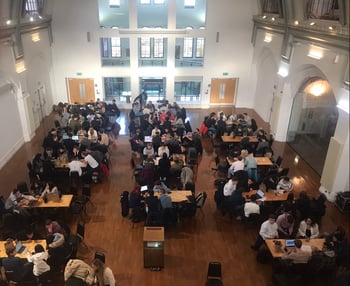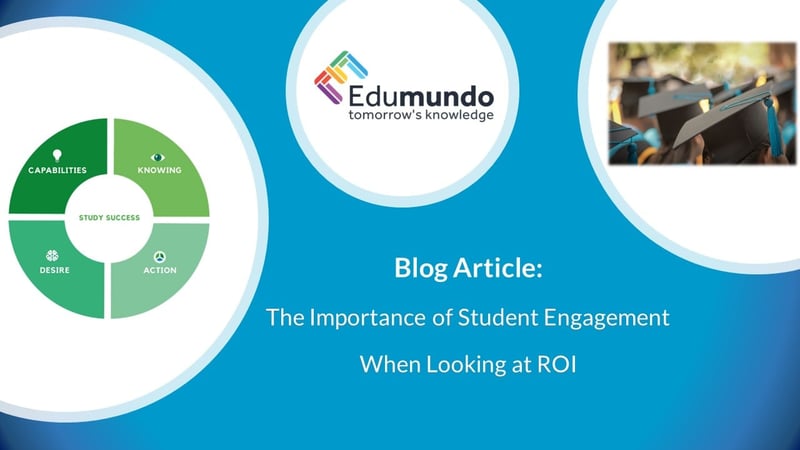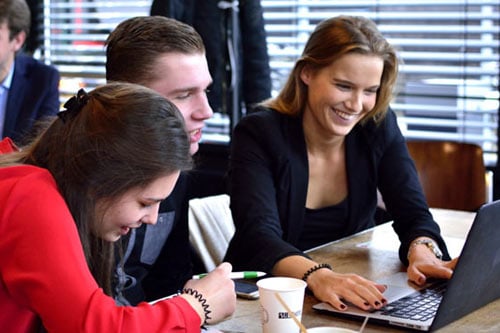Understanding that when students are engaged in learning and are using learning tools that enhance that engagement, they are leaving classrooms with knowledge and skills that create a well-rounded student who is far better prepared and more confident and capable of entering the workforce.
Going to College. The Obvious Step?
When I first went to university as a freshman, it felt like the obvious next step after high school. And I wasn’t alone in that feeling or assumption, all of my peers were doing the same; graduating high school and going off to college. And we all knew that going to college came with acquiring student loans. It seemed they were just “the cost of doing business”. This chapter of our lives was meant to be fun, challenging, growing, and it was also knowingly expensive. It was just all a part of it, and we didn’t really question it or worry too much about it. We also assumed, whether correctly or not, that when we left college a job would be waiting to cover those incurred costs.
 But things have changed, and they have changed fast. Students still expect there will be loans… a lot of loans, but they also have a whole new set of expectations about what they will get in return. In fact, a recent study found that over half of high school students wondered if college was even worth the investment (Modern Campus, 2022). For most students, finances loom at the forefront of their minds throughout their experience, often causing barriers to their completion and engagement. They need to immediately feel and see value in their education to stick with it.
But things have changed, and they have changed fast. Students still expect there will be loans… a lot of loans, but they also have a whole new set of expectations about what they will get in return. In fact, a recent study found that over half of high school students wondered if college was even worth the investment (Modern Campus, 2022). For most students, finances loom at the forefront of their minds throughout their experience, often causing barriers to their completion and engagement. They need to immediately feel and see value in their education to stick with it.
There is more of a spotlight on student loans and student debt than ever before, making understanding the return on investment (ROI) a necessary and primary focus for students and their parents. And the answer to showing them ROI, outside of statistics and facts, is reassuring them that they won’t simply leave college or university with knowledge, but they will also leave with skills. And that combination will mean that they will be not just ready academically speaking to get a job but they will be a competitive candidate who will have what it takes to succeed within that job once they get it.
Students want to know what they are getting out of their education from beginning to end, and who can blame them? It is a huge investment, and it’s important that they do their homework and ask the questions, and that as educators we are placing a value on helping them better understand their career trajectory within higher education as well as what skills they will gain along the way.
ROI, Experiential Learning, and Student Engagement
Getting students engaged isn’t always easy. And a huge part of this is that no two students are the same, and they aren’t there for the same reasons nor do they have the same circumstances with which they got there. So, you have to be creative sometimes.
So how do we really achieve a positive ROI for students entering university? I would suggest that ROI, experiential learning and engagement go hand-in-hand. If a student knows and understands the value, you can get them through the door. If you use unique tools that provide lasting learning, you can instil skills and learning that endure beyond the door to the classroom or the day after an exam. And if you can make learning engaging, you allow students to build upon the knowledge they have gained and grow as individuals and strengthen their bonds within their communities. They not only gain value from their experience, but they remember it, know how to utilise it, and look back positively upon it.
Higher education gives students a lot more than just their degree. They gain so many important tools inside and outside of the classroom, interacting with their professors and classmates, staying up late to complete projects, eating Ramen day in and day out etc. all of these help to develop important tools needed to be successful in the workforce (well, perhaps aside from the Ramen). Students learn how they learn and they use that understanding to be more successful, they also learn how to apply knowledge, to build a community, and to make personal and professional connections that will last well beyond their tenure in college.
Getting students engaged isn’t always easy. And a huge part of this is that no two students are the same, and they aren’t there for the same reasons nor do they have the same circumstances with which they got there. So, you have to be creative sometimes.
Building Teams to Build Towers
This silent and serious class transformed to organised mayhem! They wanted to win, they wanted to do a good job, they understood they needed to work together to do so, and they started to communicate, use their unique skillsets in tandem with their classmates, and ultimately, engage.
One of my first classes I taught was a communication-focused small group course. It was a required course of individuals who were primarily engineering students. Of the 20, roughly one wanted to be there and that became very clear when I assigned an entire book to read and asked the students to discuss. The book was one that typically provoked vibrant discussions. But for this group… it was crickets. And as a mom, I wasn’t mad about some silence in my life, but in this moment, I was ready to hear their voices, understand their thoughts, see their viewpoints. But I also knew I needed to make a shift in order to get there. So, I let them go early that day and went straight to the store. Next class, I split the group into four teams of 5 and gave them each a bag of marshmallows and a package of spaghetti. I gave them 15 minutes and challenged them to make the tallest structure they could, and I made sure to have treats for the winners. This silent and serious class transformed to organised mayhem! They wanted to win, they wanted to do a good job, they understood they needed to work together to do so, and they started to communicate, use their unique skill-sets in tandem with their classmates, and ultimately, engage. And guess what… that engagement didn’t go away when the marshmallows did.
 After this activity, we reflected on the shift and what had made them engage now versus before. They reflected that once they started to have fun, feel pride in their work and a connection to their classmates, they found value in what they were doing and it made sense for them to be there, do the work and do it well.
After this activity, we reflected on the shift and what had made them engage now versus before. They reflected that once they started to have fun, feel pride in their work and a connection to their classmates, they found value in what they were doing and it made sense for them to be there, do the work and do it well.
Experiential learning adds value and helps students to instantly and continually feel part of a team and a community. They build skills that are lasting. Learning outcomes are achieved in ways that are creative, holistic and mimic what the students will be doing in the real world. In short, they work.
I had no idea what the outcome of the marshmallow and spaghetti project was going to be when I went into my class that day, I just knew that something needed to shift and change or those students were going to show up to class because they had to, and take away very little in return for their time because they didn’t feel connected or engaged. It was a waste of their time, and in turn they felt it was a waste of their money. Perhaps it was luck that day that helped me to flip the switch and have a class willing to deep dive into discussions and readily provide their thoughts and opinions moving forward… or perhaps it was that I had changed. I had looked at what I was doing to teach them and realised it wasn’t going to work anymore. And once that change happened, we all won.
Using Business Simulations as Experiential Learning Tools
As I said, engagement isn’t easy, but what I have learned is that you have to meet students where they are at. And right now, they are in a place where they want to understand why they are there. What is the value-add?
College is not just a blip of time, but an important stage of life for many that serves as a foundation for so much afterwards. And universities can help to bolster that experience through enhanced student engagement and experiential learning. This is where they can help to further that knowledge and skill combination. Experiential learning through business simulations deepens the learning experience with real world scenarios. It works to expand the bonds of community within classrooms as students work through those scenarios together, compete against one another, identify roles, make mistakes, adapt, learn, and grow in a space that is organically embedding knowledge and understanding of the course concepts while also teaching valuable skills students can apply in the real world.
So, as we look at college and university through the lens of ROI, I suggest we look at it with engagement in mind. Understanding that when students are engaged in learning and are using learning tools that enhance that engagement, they are leaving classrooms with knowledge and skills that create a well-rounded student who is far better prepared and more confident and capable of entering the workforce.
About the Author

Dr. Megan Swanson is our Business Development Manager for North America. With previous academic teaching experience at Higher Education level, she holds a PhD in Clinical and Sport Psychology and Master of Education, focussing on Curriculum Design and Instruction.
Interested in discussing this blog article and finding out more about our catalogue of business simulations and gamification tools? Book a free meeting with Megan below.
CASE STUDIES
Check out our library of case studies to see how our academic partners have used simulations in their teaching.
CITATIONS
- "Why and How to Show Students the ROI of Education" (2022), Modern Campus, Accessed on: 01/04/2023; Accessed from: https://moderncampus.com/blog/why-and-how-to-show-roi-of-education-to-students.html



.png?length=300&name=unnamed%20(11).png)
.png?length=300&name=unnamed%20(7).png)
.png?length=300&name=unnamed%20(8).png)
.png?length=300&name=unnamed%20(6).png)

.png?length=300&name=unnamed%20(10).png)
.png?length=300&name=unnamed%20(5).png)
.png?length=300&name=unnamed%20(9).png)
.png?length=300&name=unnamed%20(4).png)
.png?length=300&name=unnamed%20(2).png)
.png?length=300&name=unnamed%20(1).png)
.png?length=300&name=unnamed%20(3).png)
.jpg?length=300&name=unnamed%20(2).jpg)





.png?length=300&name=loughborough-university-logo%20(small).png)





